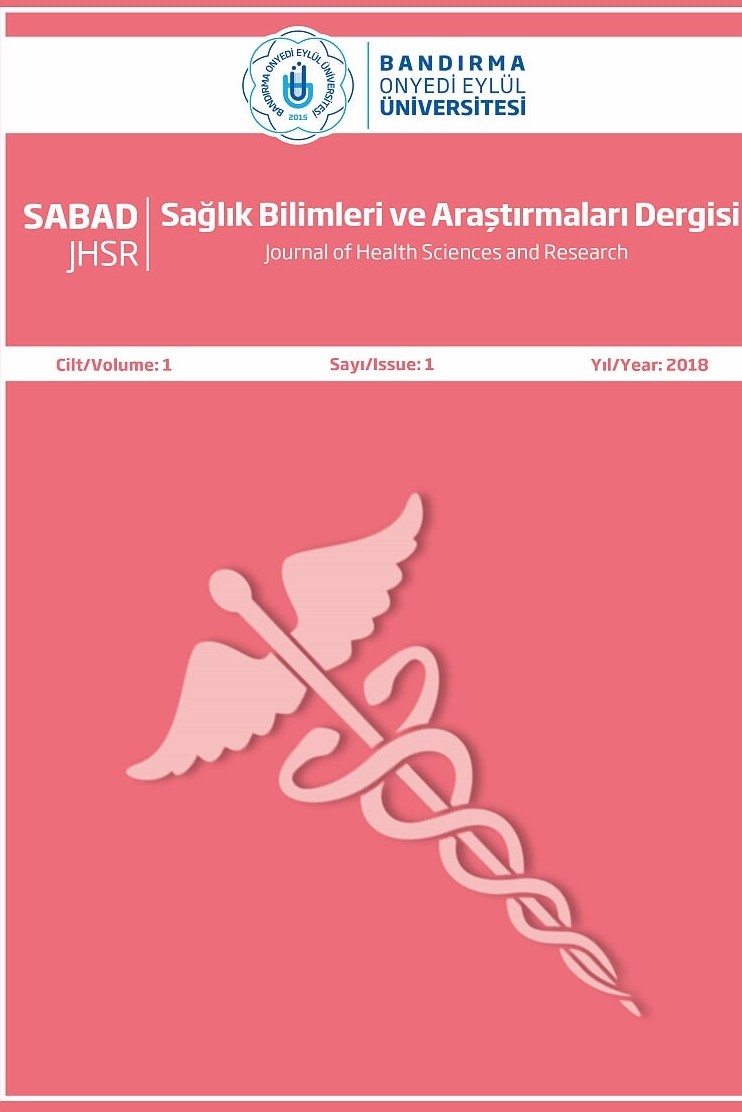Aile Sağlığı Merkezlerinde Görev Yapan Hemşire ve Ebelerin Çocuk İstismarı ve İhmali Hakkındaki Bilgi Düzeylerinin Değerlendirilmesi
An Evaluation of the Knowledge Level of Nurses and Midwives Working in Family Health Centers about Child Abuse and Neglect
Child abuse, Midwife, Nurse, Neglect, Abuse,
___
- Akcan, A, Demiralay, Ş. (2016). Perceptıons of department of nursıng students on chıld neglect and abuse. Journal of Research in Education and Teaching, 5(32), 275-281.
- Aktay, M. (2020). Effects and Treatment of Abuse and Neglect on Children. Journal of Development and Psychology, 1(2), 169-184.
- Ben Yehuda, Y., Attar-Schwartz, S., Ziv, A., Jedwab, M., Benbenishty, R. (2010). Child abuse and neglect: reporting by health professionals and their need for training. The Israel Medical Association Journal: IMAJ, 12(10), 598–602.
- Büyük, E.T. (2019). The effect of training program on the knowledge level of midwifery students about child abuse. Journal of Nursing and Midwifery Sciences, 6(4), 171-176. doi: 10.4103/JNMS.JNMS_54_18
- Canbaz, S., Turla, A., Aker, S., Pekşen, Y. (2005). Knowledge and attitude of general practitioners working in primary health-care centers in Samsun-city center about child abuse and neglect. Journal of Continuing Medical Education,14(11), 241-246.
- Çatık, A., Çam, O. (2006). Determining nurses’ and midewives’ level of knowledge on symptoms and risk of child abuse and neglect. Journal of Ege University Nursing Faculty, 22(2), 103-119.
- Child Protection Law Turkey, 2005. Release Date:15/07/2005 Sayı: 25876.
- Eckenrode, J., Ganzel, B., HendersonJr, C. R., Smith, E., Olds, D. L., Powers, J., … Sidora, K. (2000). Preventing child abuse and neglect with a program of nurse home visitation: The limiting effects of domesticviolence. Jama, 284(11), 1385-1391. doi:10.1001/jama.284.11.1385
- Ezzati M., Lopez AD., Rodgers A., Murray, C. (2004). Child sexual abuse. Comparative Quantification of Health Risks, Geneva, Switzerland, WHO, 1(1), 29-88.
- Gardner, M. J., Thomas, H. J., & Erskine, H. E. (2019). The association between five forms of child maltreatment and depressive and anxiety disorders: A systematic review and meta-analysis. Child abuse & neglect, 96, 104082.
- Gölge, ZB., Hamzaoglu, N., Türk, B. (2012). Assesment of medical staff awareness about child abuse and neglect. Turkish Journal of Forensic Medicine, 6(2), 86-96. doi: 10.5505/adlitip.2012.36349.
- Han, K., & Oh, S. (2022). The effectiveness of home visiting programs for the prevention of child maltreatment recurrence at home: a systematic review and meta-analysis. Child Health Nursing Research, 28(1), 41.
- Henry, B. M., Ueda, R., Shinjo, M., Yoshikawa, C. (2003). Health education for nurses in Japan to combat child abuse. Nursing & Health Sciences, 5(3), 199-206. doi: 10.1046/j.1442-2018.2003.00153.x.
- Kim, H., Flowers, N., & Song, E. J. (2022). Community home visiting services and child maltreatment report rates, Illinois zip codes, 2011–2018. Child Abuse & Neglect, 134, 105884.
- Lansford, J. E., Miller-Johnson, S., Berlin, L. J., Dodge, K. A., Bates, J. E., Pettit, G. S. (2007). Early physical abuse and later violent delinquency: a prospective longitudinal study. Child Maltreatment, 12(3), 233–245. doi: 10.1177/1077559507301841.
- Lee I. S., Kim K. J. (2018). Factors That Influence Mandatory Child Abuse Reporting Attitudes of Pediatric Nurses in Korea. J Forensic Nurs, 14(1), 31-41. doi: 10.1097/JFN.0000000000000186.
- Lines, L. E., Hutton, A., & Grant, J. M. (2020). Navigating and negotiating meanings of child abuse and neglect: Sociocultural contexts shaping Australian nurses’ perceptions. Health & social care in the community, 28(3), 941-949.
- Metinyurt, H., Sarı, H. (2016). Awareness of Health Professionals About Child Abuse and Neglect. Çocuk ve Medeniyet Dergisi, 1(3), 101-121.
- Özbey, H., Gökçe, A. Ö., Gül, U., Kahriman, İ. (2018). Knowledge and awareness of nursing students about child abuse and neglect. Journal of Nursing Research and Practice, 2(3),21-24.
- Pala, B., Ünalacak, M., Ünlüoğlu, İ. (2011). Child maltreatment: Abuse and neglect. Dicle Medical Journal, 38(1).
- Simon, J., Luetzow, A., Conte, J. R. (2020). Thirtyyears of the Convention on theRights of the Child: developments in child sexual abuse and exploitation. Child Abuse & Neglect, 104399. doi: 10.1016/j.chiabu.2020.104399
- Tanşu, A., Karadaş, E. (2011, Ekim). Acil servise başvuran çocuk hastalar ile çalışan sağlık profesyonellerinin çocuk istismarı ve ihmaline yönelik farkındalık düzeylerinin belirlenmesi. Sözel Bildiri, Milli Pediatri Kongresi, Antalya.
- Turhan, E., Sangün, Ö., İnandı, T. (2006). Child abuse and prevention in primary care. Journal of Continuing Medical Education, 15(9), 153-157.
- Turkish Statistical Institute 2014. Retrieved October 28, 2021, https://data.tuik.gov.tr/Bulten/Index?p=Dunya-Nufus-Gunu-2022-45552
- U.S. Department of Health & Human Services (2011). Child Maltreatment, Children’s Bureau. Retrieved December 20, 2021,https://www.acf.hhs.gov/sites/default/files/cb/cm11.pdf.
- Unicef (2016). Preventing child maltreatment: a guide to taking action and generating evidence. Retrieved December 19, 2021, https://apps.who.int/iris/bitstream/handle/10665/43499/9241594365_tur.pdf?sequence=21&isAllowed=y
- Children’s Bureau. (2018). Child Maltreatment. Retrieved December 04, 2022, https://www.acf.hhs.gov/sites/default/files/documents/cb/cm2018.pdf.
- Uysal, A (1998). Çocuk İstismarı ve İhmalinin Belirti ve Risklerini Tanılamada Hemşire ve Ebelerin Bilgi Düzeylerinin Saptanması. (Yayımlanmamış Yüksek Lisans Tezi). Ege Üniversitesi, Sağlık Bilimler Enstitüsü, İzmir.
- Zusman, N., Saporta‐Sorozon, K. (2022). Organizational factors affecting nurses’ tendency to report child abuse and neglect. Public health nursing, 39(3), 601-608.
- Yayın Aralığı: Yılda 3 Sayı
- Başlangıç: 2019
- Yayıncı: Bandırma Onyedi Eylül Üniversitesi
Hacer KABAKOĞLU, Hatice TAMBAĞ
İrritabl Bağırsak Sendromlu Hastalarda Laktoz İntoleransı ve Osteoporoz Gelişimi
Melis AYCAN, Aylin AÇIKGÖZ PINAR
Derin Gömük İkinci Büyük Azı Dişleri: İki Olgu Sunumu
Gülce Ecem DOĞANCALI, Betül GEDİK, Abdulkadir Burak ÇANKAYA, Mehmet Ali ERDEM
Gebelerde Koronavirüs Anksiyetesi ve Belirsizliğe Tahammülsüzlük Düzeyi İlişkisi
Derya EŞSİZ SELİMOĞLU, Kerime Derya BEYDAĞ
Aysel ŞAHİN KAYA, Tarkan YETİŞYİĞİT, Ahsen YILMAZ, Savaş GÜZEL, Aslı AKYOL MUTLU
Gebelikte Hipofizer Hastalıklar ve Hemşirelik Bakımı
Elif BALKAN, Meltem MECDİ KAYDIRAK, Nevin HOTUN ŞAHİN
Hande SABANDÜZEN, Öznur KAVAKLI
Leylicem SEÇGİN, Kevser TARI SELÇUK
Lise Öğrencilerine Uygulanan Sınav Kaygısını Yönetme Programının Sınav Kaygısı Üzerindeki Etkisi
